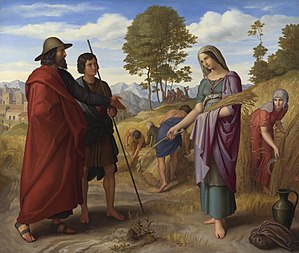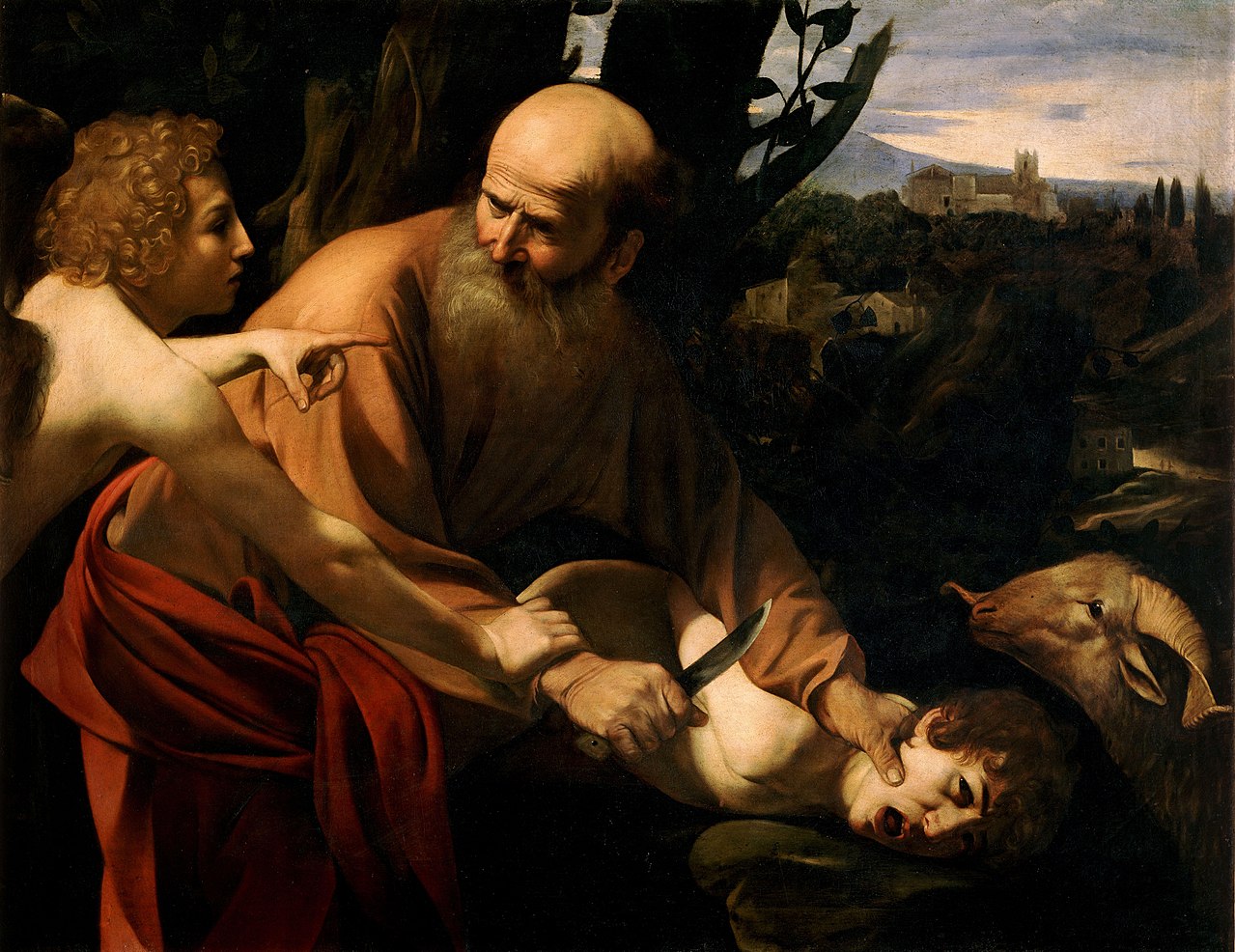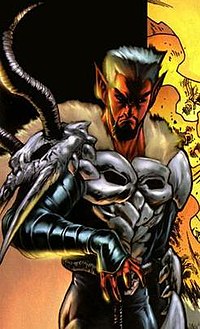
An artist’s rendering of the original scapegoat – created by Moses in the Book of Leviticus…
* * * *
Today – May 2 – was a major Feast Day. (See Philip and James – Saints…) Meanwhile, it’s time for an update on some recent Daily Office Bible Readings.
Starting last Sunday – April 24 – the Old Testament readings have been from the Book of Leviticus. That’s the third book of the Bible. (I.e., third of the Greek Old Testament in the Christian canon, and third of five books of the Hebrew Pentateuch.)
 The English name of the book derives from the Greek meaning “things pertaining to the Levites.”
The English name of the book derives from the Greek meaning “things pertaining to the Levites.”
The title refers to “the Levites, the tribe of Aaron, from whom the Kohanim (‘priests’) descended.” The Book of Genesis – which Moses wrote during the 40 years of Wilderness Wandering – said that Levi – shown at right – was the third of 12 sons of Jacob. In turn he was “the founder of the Israelite Tribe of Levi (the Levites.”)
Basically, Leviticus is one long book of rules. (Having to do with ritual.) Or as Wikipedia noted, “The instructions of Leviticus emphasize ritual, legal and moral practices rather than beliefs.” And as Isaac Asimov noted, “It’s instructions are of primary interest to the priesthood.”
It’s also the most boring book in the Bible: “virtually one long section … given over to ritualistic detail, so that it is easily the dullest book in the Bible to the casual reader.” (Asimov.)
One result: If you start reading the Bible as if it were a novel, Leviticus is where you’ll most likely get bogged down. See for example “Bible basics” revisited:
Unfortunately, many people start reading the Bible as if it were a novel… They start at the very beginning and move toward the end. But they tend to bog down in Leviticus. (If they get that far.)
 In turn, “Bible basics” also talked about how Jesus solved the problem by boiling the whole Bible down to two simple shoulds. (A kind of CliffsNotes summary, as detailed In Matthew 22:37-39.)
In turn, “Bible basics” also talked about how Jesus solved the problem by boiling the whole Bible down to two simple shoulds. (A kind of CliffsNotes summary, as detailed In Matthew 22:37-39.)
But even with that CliffsNote summary from Jesus, Leviticus is still a tough read. Which reminds us that the key is not to try and read the Bible like a novel, from beginning to end.
The better way is to read the Bible using the Daily Office. That’s a cycle of four relatively short readings done “on a daily basis.” That cycle will get you through virtually the entire Bible in two years. (And the Psalms and Gospels three to four times.)
Which brings us back to some recent Daily Office Readings. (Especially recent Old Testament readings from the Book of Leviticus.) Take – for example – the reading for last Thursday, April 28: Leviticus19:26-37. It contained some gems, like Leviticus 19:32.
There are various translations, but the one I like says this: “Honor the face of an old man.” (And as a representative of that “discrete and Insular minority,” I appreciate the thought.)
And speaking of the immigration controversy, here’s what the Bible says in Leviticus 19:33–34:
When an alien resides with you in your land, you shall not oppress the alien. The alien who resides with you shall be to you as the citizen among you; you shall love the alien as yourself, for you were aliens in the land of Egypt: I am the Lord your God. (E.A.)
In other words, the Bible says we here in America should treat “aliens” – legal or otherwise – as “citizens among us.” Whether conservatives – Christian or otherwise – agree with that thought is an entirely different matter. I’m merely making the point that those are two of the thought-provoking gems that I found in the OT reading for April 28, as Leviticus19:26-37.
 There’s a similar gem in the reading for the day before, Wednesday, April 27. It held a similar thought on dealing with the poor and downtrodden: “It is the same with your grape crop – do not strip every last bunch of grapes from the vines, and do not pick up the grapes that fall to the ground. Leave them for the poor and the foreigners living among you.” (You can see the same note in Deuteronomy 24:20 and Ruth 2:2, shown at right.)
There’s a similar gem in the reading for the day before, Wednesday, April 27. It held a similar thought on dealing with the poor and downtrodden: “It is the same with your grape crop – do not strip every last bunch of grapes from the vines, and do not pick up the grapes that fall to the ground. Leave them for the poor and the foreigners living among you.” (You can see the same note in Deuteronomy 24:20 and Ruth 2:2, shown at right.)
Then there were the Old Testament readings for last Monday and Tuesday – April 25 and 26 – to wit: Leviticus 16:1-19 and Leviticus 16:20-34. Those readings brought up the idea of a “scapegoat.” The earliest mention of such a scapegoat came in Leviticus 16:6-10:
“Aaron is to offer the bull for his own sin offering to make atonement for himself and his household… He is to cast lots for the two goats – one lot for the Lord and the other for the scapegoat. Aaron shall bring the goat whose lot falls to the Lord and sacrifice it for a sin offering. But the goat chosen by lot as the scapegoat shall be presented alive before the Lord to be used for making atonement by sending it into the wilderness as a scapegoat. (E.A.)
 I wrote about these passages in On scapegoating.
I wrote about these passages in On scapegoating.
That is, scapegoating – illustrated at left – is “the practice of singling out any party for unmerited negative treatment or blame as a scapegoat.” (Which itself could allude back to the immigration controversy, noted above.)
For a thoroughly modern take on the phenomenon, see Scapegoating – An Insidious Family Pattern of Blame and Shame on One Family Member. That article was written up by Feeling Expert Lynne Namka:
Scapegoating is a serious family dysfunctional problem with one member of the family or a social group being blamed for small things, picked on and constantly put down. In scapegoating, one of the authority figures has made a decision that somebody in the family has to be the bad guy. The mother or father makes one child bad and then looks for things (sometimes real, but most often imagined) that are wrong.
She added, “Scapegoating is a huge social problem contributing to the hate that exists in the world.” (Which sounds about right, considering some current political discourse. See for example Why I Hate the Politics of Hate.) But was that the Bible’s original idea?
Getting back to Isaac Asimov : He said that much of Leviticus “deals with the clean and unclean,” but that the “Biblical use of the term of involves religious ritual.” (As opposed to the purely hygienic sense we use today.) As Asimov further explained:
Something is clean if it may be offered as a sacrifice for God, or if it may stand in the presence of God. Something that may not be offered as a sacrifice is unclean… Perhaps the chief thing [in] the book of Leviticus was to work out a code of behavior that would serve to keep the Jews distinct and their religion intact from the attractions of surrounding cultures.
 (156-57) And incidentally, one of those “attractions of surrounding cultures” was child sacrifice. I noted that prevailing practice – at the time of Abraham – in Readings for June 29 (2014). That post included details on the episode where Abraham stood ready to sacrifice his son Isaac. See also Binding of Isaac (illustrated at right):
(156-57) And incidentally, one of those “attractions of surrounding cultures” was child sacrifice. I noted that prevailing practice – at the time of Abraham – in Readings for June 29 (2014). That post included details on the episode where Abraham stood ready to sacrifice his son Isaac. See also Binding of Isaac (illustrated at right):
[C]hild sacrifice was actually “rife among the Semitic peoples. . . [I]n that age, it was astounding that Abraham’s God should have interposed to prevent the sacrifice, not that He should have asked for it.” [The episode demonstrated] to the Jews that human sacrifice is abhorrent… God wanted to change some “prevailing practices…” In this case, God apparently felt a prevailing practice needed to be changed.
And the point of all that could well be that God is not necessarily “conservative.” See also On Jesus: Liberal or Fundamentalist? Sometimes – like when there was rampant child sacrifice at the time of Abraham – God felt the need to step in and change things.
But of course that thought could open up a whole new can of worms. The point I’m making here is that maybe it’s a good idea to see what Moses originally meant.
Asimov also noted, “the Hebrew word that is translated as ‘scapegoat’ in the King James Version is actually Azazel.” (158) And you can see the difference in several “non-KJV” translations of Leviticus 16:8. For example, the English Standard Version reads: “And Aaron shall cast lots over the two goats, one lot for the LORD and the other lot for Azazel.”
The New Living Translation reads like this: “He [Aaron] is to cast sacred lots to determine which goat will be reserved as an offering to the LORD and which will carry the sins of the people to the wilderness of Azazel.” (Emphasis added.)
 You can see more background on “Azazel” in On scapegoating. But there was apparently both a “wilderness of Azazel” and a demon named Azazel, who could be “regarded simply as the personification of wickedness.” And more than that, he – the demon Azazel – reappeared in 2003 as a “comic book supervillain.” See Azazel (Marvel Comics) – Wikipedia. (As shown at left.) But finally, Asimov noted this:
You can see more background on “Azazel” in On scapegoating. But there was apparently both a “wilderness of Azazel” and a demon named Azazel, who could be “regarded simply as the personification of wickedness.” And more than that, he – the demon Azazel – reappeared in 2003 as a “comic book supervillain.” See Azazel (Marvel Comics) – Wikipedia. (As shown at left.) But finally, Asimov noted this:
Azazel is mentioned nowhere else in the Bible save for this one chapter, but it seems quite likely that it is the name of a demon thought of as dwelling in the wilderness. It might be pictured as an evil spirit that is the source of sin. In sending the second goat into the wilderness, the sins it carried could be viewed as returning to their source. (E.A.)
(158) So the original intent of this Bible passage was apparently not to single out one innocent person to suffer for the sins of many. (As so often happens these days.)
In turn, maybe- just maybe – it’s high time to make some changes. Maybe – just maybe – it’s time to stop scapegoating people, just like it was time to stop the prevailing child sacrifice in Abraham’s time. Maybe – just maybe – it’s time to stop scapegoating any and every person “who, himself innocent, suffers vicariously for the deeds of others.”
But of course, some old habits DO die hard…

* * * *
The upper image is courtesy of Book of Leviticus – Wikipedia, the free encyclopedia. The caption: “The Scapegoat (1854 painting by William Holman Hunt).”
The image of Levi is courtesy of Wikipedia. The caption: “Levi, from the Twelve sons of Jacob, Holland c. 1590.” The “circa 1590” explains the anachronistic style of Levi’s clothing.
Re: Leviticus. The Isaac Asimov quotes on scapegoat and Leviticus – including that it’s “instructions are of primary interest to the priesthood” – are from Asimov’s Guide to the Bible: Two Volumes in One, the Old and New Testaments, Avenel Books (1981), at pages 156-59. Asimov also noted that another term translated as “devils” literally meant – in the original Hebrew – “wild goats.”
Asimov (1920-1992) was “an American author and professor of biochemistry at Boston University, best known for his works of science fiction and for his popular science books. Asimov was one of the most prolific writers of all time, having written or edited more than 500 books and an estimated 90,000 letters and postcards.” His list of books included those on “astronomy, mathematics, the Bible, William Shakespeare’s writing, and chemistry.” He was a long-time member of Mensa, “albeit reluctantly; he described some members of that organization as ‘brain-proud and aggressive about their IQs.’” See Wikipedia.
Also, for a post on the distinction between that book and Deuteronomy, see On the readings for December 7. Essentially, in Deuteronomy the addresses of Moses – to the Hebrews as they neared the promised land – “recapitulate the events of the Exodus and restate key portions of the law as it was received from Sinai.” That post concluded that “the Bible was written by people just like us,” to show that “we too can accomplish miracles just like Jesus and the rest of the Bible-writers did. See John 14:12, “Very truly, I tell you, the one who believes in me will also do the works that I do and, in fact, will do greater works than these, because I am going to the Father.” (Emphasis added.)
Re: ““discrete and Insular minority.” See also Suspect classification – Wikipedia.
Re: “same note.” See Deuteronomy 24:20: “When you beat the olives from your trees, do not go over the branches a second time. Leave what remains for the foreigner, the fatherless and the widow.” Also Ruth 2:2: “And Ruth the Moabite said to Naomi, ‘Let me go to the fields and pick up the leftover grain behind anyone in whose eyes I find favor.” Naomi said to her, ‘Go ahead, my daughter.'”
The “Ruth” image is courtesy of Book of Ruth – Wikipedia. The caption: “Julius Schnorr von Carolsfeld: ‘Ruth in Boaz’s Field,’ 1828.”
The image to the left of the first scapegoating paragraph(s) is courtesy of Wikipedia. The caption: “Scapegoat, 2012, bronze sculpture.” Although the Wikipedia article doesn’t include an attribution, the sculpture is apparently the work of Christine JONGEN (1949) – Artprice.com.
 See also the Wikipedia article on Dido: “according to ancient Greek and Roman sources, the founder and first queen of Carthage (in modern-day Tunisia).” The article included the image at left, with the caption: “Christine Jongen, Dido, bronze sculpture, 2007-08.”
See also the Wikipedia article on Dido: “according to ancient Greek and Roman sources, the founder and first queen of Carthage (in modern-day Tunisia).” The article included the image at left, with the caption: “Christine Jongen, Dido, bronze sculpture, 2007-08.”
I borrowed the lower image from the post, On scapegoating. The attribution there is from “fridayfunfact.files.wordpress.com/2011/12/scapegoat.jpg.”